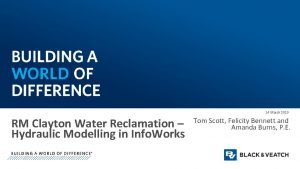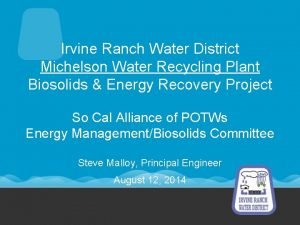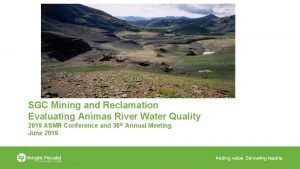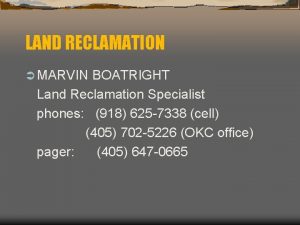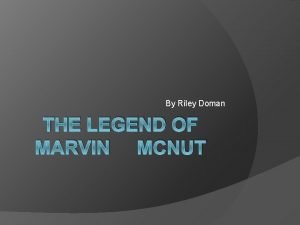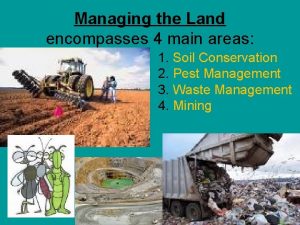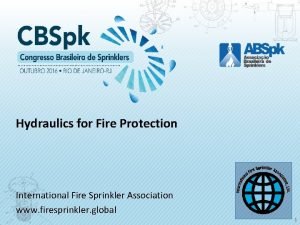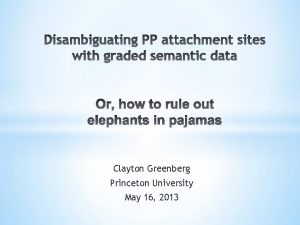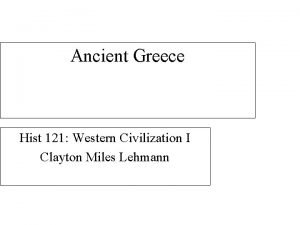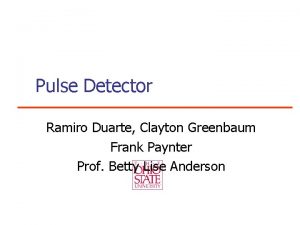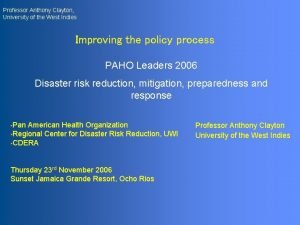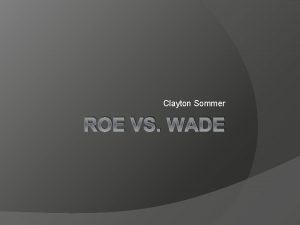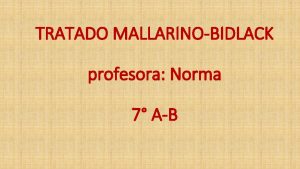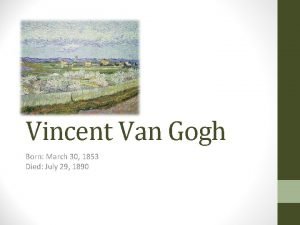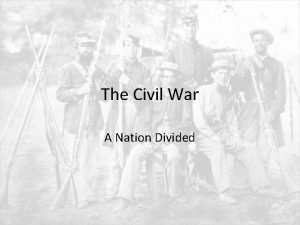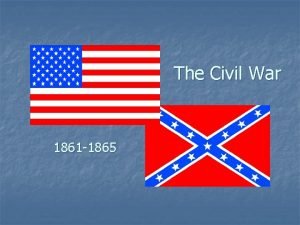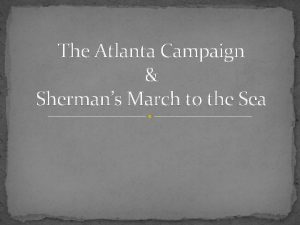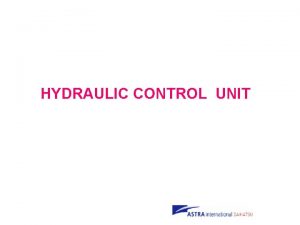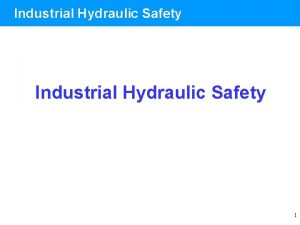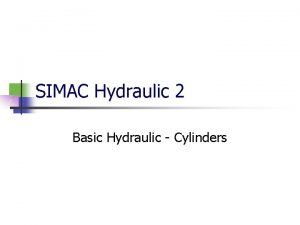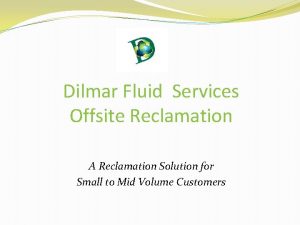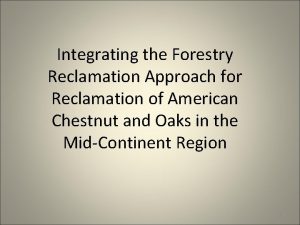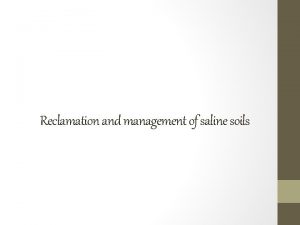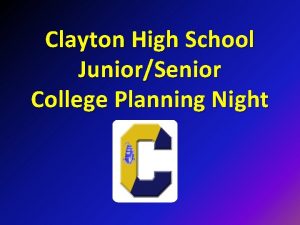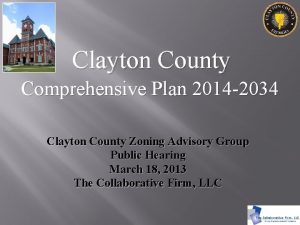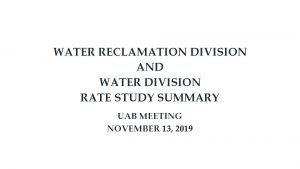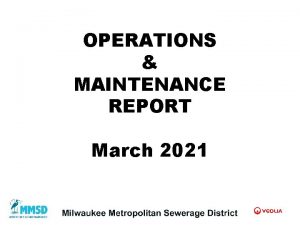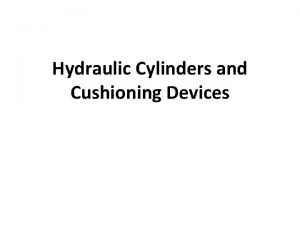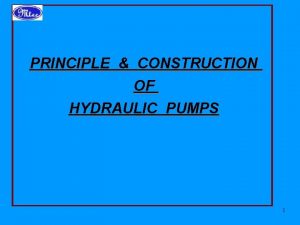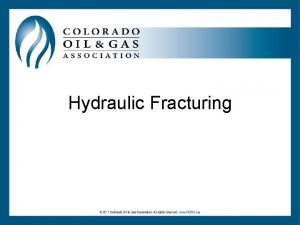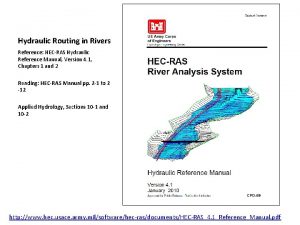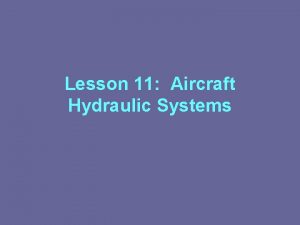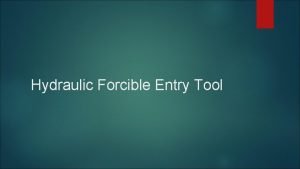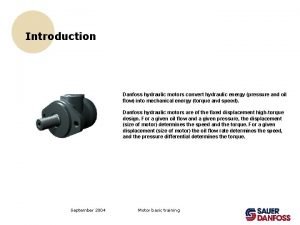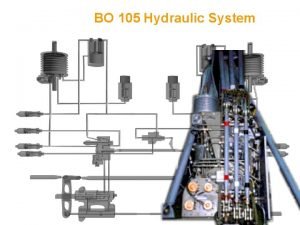14 March 2019 RM Clayton Water Reclamation Hydraulic







































- Slides: 39

14 March 2019 RM Clayton Water Reclamation – Hydraulic Modelling in Info. Works Tom Scott, Felicity Bennett and Amanda Burns, P. E.

Background • City of Atlanta wanted hydraulic model of RM Clayton wastewater plant • Already had a very complicated spreadsheet • Info. Works ICM specified so could be integrated with upstream collection system model • Model built from scratch and then calibrated • 240 MGD (10. 5 m 3/s) plant design flow 2

Why use ICM to model Treatment Plant Hydraulics? • Dynamic model vs. traditional static spreadsheets • • Flow splits and flooding automatically calculated Model routing Pump/gate/valve controls can be modeled Graphical interface and outputs • Third-party software • Opportunity for integrating with collection system model • Model dynamic downstream conditions • Examine WWTP operations effect on collection system • Assess aging collection system infrastructure (more I/I) effects on WWTP operations 3

Model Overview • Info. Works ICM version 5. 5 • Large works with typical treatment components: • Headworks with coarse bar screens • grit removal and drum screens • 8 x primary clarifiers • 2 x Biological Nutrient Removal • (BNR) basins • Mixed liquor pumping station • 10 x secondary clarifiers • 22 x effluent filters • 5 x Ultraviolet (UV) • Outfall 4

Model Overview • 840 nodes and 1174 links • 120 gates/sluices to enable individual units to be taken offline • 6 bypasses • Existing Plant from inlet chamber to Chattahoochee River • Proposed new grit removal plant (isolated for calibration) • Different scenarios created: • Base model – current arrangement with typical units in service • Calibration (20 Feb – 26 Mar) – units in service at time • Calibration (5 – 6 Apr) – units in service at time • Other scenarios for simulating different number of UV lanes in service. 5

Data Acquisition and Survey 6

Data Acquisition and Survey • A detailed site survey was undertaken: • To obtain dimensions which could not be obtained from record drawings • To verify key hydraulic information, such as weir levels • To obtain invert levels for temporary monitor locations to convert measured depths into elevations • Surveyed elevations showed a universal offset relative to site record drawings with surveyed elevations higher • Average difference of 120 mm determined by comparing elevations at a number of locations where levels were known from record drawings. 7

Data Acquisition and Survey • During the survey we identified: • If available control levels conformed to record drawings • Field measurements for each process component and conveyance network • Survey benchmarks for each process area • Site visits to confirm the survey pin locations and coordinate with model development. • Geo-reference of the plant layout into the hydraulic modelling software • Equipment headloss curves, pump curves • The existing Foxboro SCADA system recorded levels • Portable ultrasonic level meters 8

Model Build 9

Headworks Drum Screen Head/Discharge Curve

Clarifier Tank 8 Gate 35% Open Primary Clarifiers Primary Influent Channel Primary Bypass Gate Primary Effluent Channel Launder Channel V-Notch Weir Flow Split and Clarifier Sluice Gates

Biological Nutrient Removal (BNR) BNR 1 Plant Process Unit No. of Units Hydraulic Model Element Used Basins 190 Links-Channels Influent Effluent Channels 130 Links-Channels Sluice Gates 24 Links-Sluice Weirs 42 Links-Weir Orifice 62 Links-Orifice BNR 2

Mixed Liquor Pumping Station Mixed Liquor Pump Head/Discharge Curve

Secondary Clarifiers Plant Process Unit No. of Units Hydraulic Model Element Used Tanks 10 Nodes-Storage Pipes 36 Links-Conduits Weirs- RAS Removal 92 Links-Weir Orifice 10 Links- Orifice Launder Channels 80 Links-Conduits

Effluent filters Plant Process Unit No. of Units Hydraulic Model Element Used Influent Effluent Channels 140 Links-Conduits Weirs 24 Links-Weir Sluice Gates 22 Links-Sluice Filter Media 22 Links- User Control Flumes 21 Links-Flume Filter Media Head/Discharge Curve

UV System Trojan UV 400 Units Head/Discharge Curve

Outfall Diffuser Plant Process Unit No. of Units Hydraulic Model Element Used Outfall and Diffuser 22 Links-Conduits Weirs 6 Links-Weir Venturi Flow Meter 2 Links-User Control Venturi Flowmeters Head/Discharge Curve

Adapting Info. Works ICM for Treatment Plant Hydraulics 18

Nodes & Links • Split links at each change of conduit dimension Preissmann Slot Actual conduit area Conduit area used by model • Use user-defined shapes for unusual conduits • If surcharged conduits, model as “pressure conduit” or increase celerity ratio • Increasing from 10 to 14. 414 reduces Preissmann slot from 2% to 1% of conduit width 19

Circular Clarifier Tanks • ICM cannot simulate flow entering along the length of a channel from another model link • Divided launder length into sections to minimize inaccuracy but confirm launder capacity using spreadsheet backwater calculation • Series of V-notch weirs, each with equal number of notches 20

Nodes & Links • Headloss Coefficients • Use “Fixed” not “Normal” headloss types • Set headloss values manually based on K values for fittings • Not variable • Set node areas accurately if routing to be modeled. Set to small area and “sealed” if no chamber in reality. 21

Head Discharge Tables • Head versus discharge tables for screens and filters. Enter number of tables if varies with e. g. d/s water depth and pick most appropriate one for each scenario 22

Weirs – Discharge Coefficients • Two discharge coefficients: • Discharge coefficient = weir coefficient • Secondary discharge coefficient = orifice coefficient (water level above roof) • Coefficients are dimensionless with default = 0. 85 • Set discharge coefficient manually depending on type • Thin plate = 0. 57 • Broad crested = 0. 544 23

Weirs – Discharge Coefficients • If weir is submerged, standard equation overestimates losses • Can select Villemonte’s equation in Simulation Parameters: • Can be unstable • Still overestimates losses for broad crested weirs • Alternative is to manually increase discharge coefficient • Don’t use built-in broad crested weir if have reverse flow or submergence 24

Sluice Gates – Discharge Coefficients • Three discharge coefficients, all with default of 1. 0 • Discharge coefficient = orifice coefficient (water level above top of gate) • Secondary discharge coefficient = weir coefficient (same issue with drowned weirs) • Overgate discharge coefficient = weir coefficient when overtopping. Only used if gate depth set 25

Sluice Gates – Discharge Coefficients • Set discharge coefficient manually based on area ratios • Use high coefficient (e. g. 10) if gate is only included to allow isolation and no headloss under normal conditions • NB ICM equation is different – typical Cd of 0. 6 equates to 0. 85 in ICM • Not variable 26

Real Time Control in Info. Works • Return activated sludge (RAS) included which automatically adjusted to 50% of incoming flow • Pumps controlled to maintain fixed sump water level • New grit plant units brought online/ offline in response to incoming flow, with delay timer and rapid flow increase over-ride • ICM can include complicated control although not intuitive and can only work sequentially Globally defined variables for wet well target level, pump control and % of Return Activated Sludge (RAS) Controls for the Mixed Liquor Pumping Station Variable Frequency Drive (VFD) Pumps Controls for the Primary Clarifier Bypass Controls for the variable discharge orifices at the Secondary Clarifiers and BNR Tanks 27

Include Notes! 28

Calibration 29

Calibration • Very difficult to calibrate a whole model – too many hydraulic breaks • To maximise success: • • Check what data is already recorded and whether it is reliable, especially flows Make logging period dependent on seeing a high flow Ensure operators log units in service and any plant bypasses Pick locations carefully to maximise calibration lengths. Concentrate on most crucial areas, e. g. where headlosses are high, freeboards are low or grit deposition could be significant • Ensure water levels, not depths are recorded. Water depth to invert is only of use if channel invert level is certain • BEWARE OF DATUM DIFFERENCES. Suggest survey of key levels across plant and measure sediment depths at the same time 30

Locations of existing SCADA and proposed level sensors Existing SCADA Equipment Proposed Level Sensor Equipment Water levels River level Effluent flow Water level Inlet flow Water levels Total mixed liquor flow Some pump speeds, pressures and flows BNR 2 total RAS BNR 1 individual RAS flows • 8 portable ultrasonic depth monitors installed from 20 th/22 nd Feb to 24 th March 2017 31

Calibration • Visual comparison of results extremely beneficial: • Can see if there is a constant offset probably datum difference; • Or difference is flow dependent headloss is over/under estimated • Quantify calibration by comparing average, min and max depths. Min and max must use the same event for measured and simulated results 32

Calibration • Can gain useful information even if a monitor is in the ‘wrong’ location • Sand filter levels varies with backwashing so normal calibration is not possible but: • Minimum level when filter clean enables calibration of downstream headlosses • Maximum level enables calibration of dirt loss assumed 33

Plant Hydraulic Capacity 34

Plant Hydraulic Capacity 35

Summary 36

SUMMARY • The observed data was used to calibrate the hydraulic model at each stage of the treatment plant. • A good correlation between observed data and model simulation was obtained with only minor model changes required. • The WRC dynamic model development is complete and is currently being used and will be linked to the three sewer collection Basins. • The model can also be used to plan future expansion projects. ICM is a good tool if a whole plant hydraulic model is required, but must be carefully adapted for accurate results 37

SUMMARY • Having the WRC hydraulic model in the same software as the sewer collection system provides ease of combining all systems into one integrated model. • The WRC model when used with the collection system helps control the end discharge conditions, especially during wet weather events. This will identify the extent of backwater conditions and resulting spills. • The model will assist in providing flow data for chemical and biological process simulations for different flow scenarios. ICM is a good tool if a whole plant hydraulic model is required, but must be carefully adapted for accurate results 38

Tom Scott Felicity Bennett Amanda Burns +64 9 -300 -9187 scottt@bv. com +44 1737 856427 bennettf@bv. com +1 312 -346 -2979 burnsam@bv. com
 Atlanta rm clayton water reclamation plant
Atlanta rm clayton water reclamation plant Fertilizer pelletizer machine
Fertilizer pelletizer machine Anthem of poland
Anthem of poland Water and water and water water
Water and water and water water Mine reclamation before and after
Mine reclamation before and after Reclamation specialist
Reclamation specialist Riley doman
Riley doman Land reclamation methods
Land reclamation methods Vetac
Vetac Grihalakshmi magazine march 2019
Grihalakshmi magazine march 2019 Kaggle march madness
Kaggle march madness Fire sprinkler density calculator
Fire sprinkler density calculator Lester cowens mississippi burning
Lester cowens mississippi burning Scsi unit fbi
Scsi unit fbi Russell odom and clay lawson
Russell odom and clay lawson Clayton greenberg
Clayton greenberg Clayton atreus
Clayton atreus Bypass trust diagram
Bypass trust diagram Ramiro duarte
Ramiro duarte John patrick clayton
John patrick clayton Clayton antitrust act
Clayton antitrust act Lockheed martin clayton
Lockheed martin clayton Clayton fopp
Clayton fopp Professor anthony clayton
Professor anthony clayton Clayton alderfer
Clayton alderfer Paul clayton facebook
Paul clayton facebook Roe vs wade background
Roe vs wade background Clayton koobs
Clayton koobs Tratado mallarino bidlack
Tratado mallarino bidlack Susan clayton wooster
Susan clayton wooster Taffye benson clayton
Taffye benson clayton Where was vincent van gogh born
Where was vincent van gogh born Genetic engineering conclusion
Genetic engineering conclusion March 1917 revolution
March 1917 revolution Sherman's march to sea map
Sherman's march to sea map Sherman's march significance
Sherman's march significance Path of sherman's march to the sea
Path of sherman's march to the sea Path of sherman's march to the sea
Path of sherman's march to the sea Nine line medevac
Nine line medevac Che guevara aleida march de la torre
Che guevara aleida march de la torre
